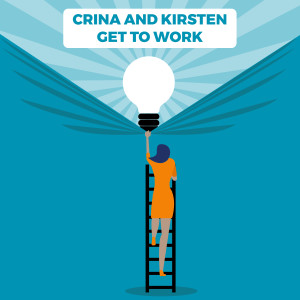
Women, work and COVID 19 adds up to a whole lot of frustration, lost wages and lost jobs. It has also exacerbated systemic issues that women have been dealing with for a very long time, most notably: The fact that women, many of whom work for minimum wage and/or in service jobs, depend on childcare, school and other social programs in order to do their jobs.
SHOW NOTES
On this episode of Crina and Kirsten Get to Work, our hosts embark on a two part series about women and Covid-19 - the effect of the pandemic on women at work. In part one, our data-driven duo delve into the data to figure out what is happening to women at work in the pandemic.
Crina revisits the basics of what we know about women at work. We make up over half of the US labor force, we make less money than men and we occupy fewer high-level and C-suite positions. We women typically have more care-taking obligations and household duties than men. The Department of Labor tells us that the top 10 jobs that women occupy are: teacher, nurse, home health aid, secretary, cashier, customer service rep, retail sales,waitress, supervisor of retail sales, managers, which require a knowledge of the management and operations of an organization, rather than a scientific, technical, or administrative specialty. 100 Years of Working Women. 25% of us have a child at home under 14. And according to the State of Women at Work survey by McKinsey and Lean In, women are doing more of all of this during the pandemic.
And the systems that support women in their work - childcare and schools - are closed, providing less services - and are basically inadequate - and this is against the backdrop that no state in our great Union offers what is considered affordable childcare, which is defined as 7% of your income. https://www.brookings.edu/essay/why-has-covid-19-been-especially-harmful-for-working-women/
As you would expect - all of this leaves women feeling stressed and anxious. Women are worrying about losing a job, the pandemic, cold-care, home-schooling, kids returning home, caregiving, racial inequity, economy - what is not stressful?
Many women have jobs that are service focused and are not conducive to remote work - which means they are dealing with masks, fear of illness for them and their families, customers and co-workers who may have their own perspective about Covid safety - in other words - hard work has become harder.
Women who are working remotely say that are more productive, but it comes at a cost - more meetings, more hours working, less distinction between work and homeRemote Work Statistics: Navigating the New Normal
The fact is that work is not working for many women. Weber Shandwick reports that 66% of their respondents in a September survey report planning to switch jobs, move to another town or cut their work to part-time. One in four are considering this due to COVID.
Four times as many women as men dropped out of the labor force in September 2020, roughly 865,000 women compared with 216,000 men. How the Coronavirus Crisis Threatens to Set Back Women’s Careers
Women leaving the labor force and reducing work hours to assume caretaking responsibilities amounts to $64.5 billion per year in lost wages and economic activity. How COVID-19 Sent Women's Workforce Progress Back
As stated by the Brooks Institute “Covid is hard on women because the U.S. economy is hard on women, and this virus excels at taking existing tensions and ratcheting them up.” Why has COVID-19 been especially harmful for working women?
We look at the systems that support women at work as social welfare systems, childcare, school, elder care, health care, but in fact they are economic development programs. Our government and society needs to develop the support structures necessary to support an important, integral and valuable aspect of our economy - women at work. Stay tuned for the next episode when our hosts discuss what next.
More Episodes
 2024-10-25
2024-10-25
 118
118
 2024-08-30
2024-08-30
 110
110
 2024-08-02
2024-08-02
 111
111
 2024-07-05
2024-07-05
 141
141
 2024-06-21
2024-06-21
 117
117
 2024-06-07
2024-06-07
 141
141
 2024-04-26
2024-04-26
 135
135
 2024-03-29
2024-03-29
 163
163
 2024-03-15
2024-03-15
 172
172
 2024-02-16
2024-02-16
 140
140
Create your
podcast in
minutes
- Full-featured podcast site
- Unlimited storage and bandwidth
- Comprehensive podcast stats
- Distribute to Apple Podcasts, Spotify, and more
- Make money with your podcast
It is Free
- Privacy Policy
- Cookie Policy
- Terms of Use
- Consent Preferences
- Copyright © 2015-2024 Podbean.com






